News Update -- We won Best Cinematography for San Diego out of 44 entrants!
-----
Last night was our premiere screening for the 48 Hour Film Project here in San Diego. We got a very pleasing reaction for our comedic short, laughs in the correct places, and it may have even won the night if it weren't for a very funny parody mashup of the PC vs. Mac commercials with the Matrix by Genesis Films (excellent work by writer/ director J.P. Pierce.) In this post I want to talk about the making of this film as it involved some totally new aquistion and post-production workflows, all in a high stress situation -- namely using a prototype camera (Silicon Imaging SI1920) with brand new editing software (the new HDR CineForm RAW within Prospect HD.) What better way to find bugs then using your own tools on a very tight deadline (although I'll have you know I do this competition for fun, not to find bugs.)
This was the third year I have entered the competition, so I should know never to go into a shot with untested equipment, but this year it couldn't be helped. Ever since signing up for the project, I was pleading to get my hands on the latest camera from Silicon Imaging. Due to situations out of my control, the new camera arrived only a few hours before the 48 hour clock started ticking. And the camera needed to be assembled from parts shipped from all over the country.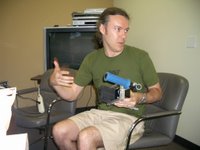 The actual SI camera is tiny, about 1.5"x 2"x3" in size, and weighs next to nothing, so setting up our rig involved adding a lot of components to make shooting on a tight schedule more practical (you can just add a lens + power and run the tiny camera in a huge range of ultra-tight spots -- anywhere you can run Ethernet cable.) SI had also provided two C-mount Super-16 primes, standard mounting rails, handles for the rail, a shoulder mount, a 7" touch-screen display with Noga arm, two Anton Bauer batteries plus charger to run the screen and camera (for many, many hours.) In addition I picked up two 100' CAT-6 cables (next time we
The actual SI camera is tiny, about 1.5"x 2"x3" in size, and weighs next to nothing, so setting up our rig involved adding a lot of components to make shooting on a tight schedule more practical (you can just add a lens + power and run the tiny camera in a huge range of ultra-tight spots -- anywhere you can run Ethernet cable.) SI had also provided two C-mount Super-16 primes, standard mounting rails, handles for the rail, a shoulder mount, a 7" touch-screen display with Noga arm, two Anton Bauer batteries plus charger to run the screen and camera (for many, many hours.) In addition I picked up two 100' CAT-6 cables (next time we 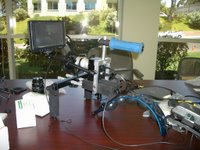 won't choose cables
won't choose cables  of the same color, as 200' of cable is a lot to untangle), a VGA to Ethernet extender, ND filters (in addition to those loaned to me -- thanks Jason), and an old 16mm Canon Zoom (off eBay) that came in very handy.
of the same color, as 200' of cable is a lot to untangle), a VGA to Ethernet extender, ND filters (in addition to those loaned to me -- thanks Jason), and an old 16mm Canon Zoom (off eBay) that came in very handy.
We used all these cables and parts to build a highly flexible tethered camera that could be up to 100 feet from the ingest station.  The ingest station was a killer Sony Viao laptop with 2.133Ghz Core Duo CPU and a 1920x1200 display (in a laptop!) The laptop runs all the camera's operations; it sets the frame rates and sizes (from 2k at 24p to 1280x720 at 72p) and controls white balance, gain, compression quality and file management (all in simple software that I had not spent much time learning.)
The ingest station was a killer Sony Viao laptop with 2.133Ghz Core Duo CPU and a 1920x1200 display (in a laptop!) The laptop runs all the camera's operations; it sets the frame rates and sizes (from 2k at 24p to 1280x720 at 72p) and controls white balance, gain, compression quality and file management (all in simple software that I had not spent much time learning.)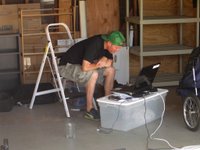 This image is of Jake (the Director, and CineForm support manager) composing the next shot (or reviewing the last) from our "video village" using the Sony VIAO.
This image is of Jake (the Director, and CineForm support manager) composing the next shot (or reviewing the last) from our "video village" using the Sony VIAO.
The laptop performed flawlessly, even though we shot for hours in direct sunlight (on the hottest day this summer in San Diego.) The Intel CPU has no issues with real-time encoding of 1080p24, and did an excellent job with 720p72 for slow motion, although the frame buffer did start to fill at this rate.  One of the beauties of the SI camera software is it has a huge buffer of frames before compression, so even if XP gets distracted, or the compressor has a lot of work to do (like 72p), the buffer allows you to get the shot. We found that at 720p72 the buffer would fill after about 30 seconds of shooting (that is 90 seconds of 24p slow motion -- so not an issue.) A 2.33GHz Core Duo would likely have no issues with the buffer level.
One of the beauties of the SI camera software is it has a huge buffer of frames before compression, so even if XP gets distracted, or the compressor has a lot of work to do (like 72p), the buffer allows you to get the shot. We found that at 720p72 the buffer would fill after about 30 seconds of shooting (that is 90 seconds of 24p slow motion -- so not an issue.) A 2.33GHz Core Duo would likely have no issues with the buffer level.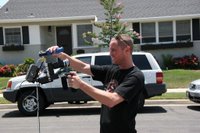 So basically we had no problems with the camera and its picture. The biggest hassle was the audio. SI camera doesn't have sound, so I purchased an M-Audio USB sampler (another eBay item) so the SI camera software could capture synced sound in laptop (into a standard AVI.) For some reason, the M-Audio sampler didn't work on the shot day. This was my fault; I never did any thorough testing of this audio hardware. So all the audio had to be shot with a Canon XL-H1, and we slated everything and sync'd the picture to sound in post (something we really shouldn't have had time for in 48 hours.)
So basically we had no problems with the camera and its picture. The biggest hassle was the audio. SI camera doesn't have sound, so I purchased an M-Audio USB sampler (another eBay item) so the SI camera software could capture synced sound in laptop (into a standard AVI.) For some reason, the M-Audio sampler didn't work on the shot day. This was my fault; I never did any thorough testing of this audio hardware. So all the audio had to be shot with a Canon XL-H1, and we slated everything and sync'd the picture to sound in post (something we really shouldn't have had time for in 48 hours.)  Now the Canon was there to be our second and back (often collecting the same scene as the SI camera), plus for pick up shoots, basically just in case we broke the SI camera. :) But during the shoot we fell in love with the images from the SI, so the Canon was hardly used for its (still beautiful) image output. One reason is that matching the look from Canon to SI would have taken more time than we had for post. Canon was used in one scene of the final movie (the first person to email me which scene can have a DVD copy for our entry.)
Now the Canon was there to be our second and back (often collecting the same scene as the SI camera), plus for pick up shoots, basically just in case we broke the SI camera. :) But during the shoot we fell in love with the images from the SI, so the Canon was hardly used for its (still beautiful) image output. One reason is that matching the look from Canon to SI would have taken more time than we had for post. Canon was used in one scene of the final movie (the first person to email me which scene can have a DVD copy for our entry.) During the shoot we used a USB/FireWire drive to move data from laptop to our editing workstations. As the CineForm RAW data is so damn small (averaging around 9MBytes/s for the new FilmScan 1 quality at 1080p24), this operation was fast, only a couple minutes for all the shots of each scene. Note: At NAB we showed an early version of CineForm RAW, which was not quite as high quality and averaged 12Mb/s+; this brand new encoder produces 20-30% lower bit-rates with higher quality. This new codec with the bit-rate drop had not yet been given to SI, so not only were we running a camera we had not used before, we were running brand new, never tested (in camera) compression, all in the spirit of this competition.
During the shoot we used a USB/FireWire drive to move data from laptop to our editing workstations. As the CineForm RAW data is so damn small (averaging around 9MBytes/s for the new FilmScan 1 quality at 1080p24), this operation was fast, only a couple minutes for all the shots of each scene. Note: At NAB we showed an early version of CineForm RAW, which was not quite as high quality and averaged 12Mb/s+; this brand new encoder produces 20-30% lower bit-rates with higher quality. This new codec with the bit-rate drop had not yet been given to SI, so not only were we running a camera we had not used before, we were running brand new, never tested (in camera) compression, all in the spirit of this competition.
You may have noticed in some of the pictures we didn't have the 7" screen attached. On the morning of the shoot, we found the screen would turn on and off at random, frustating us for shot setup (and therefore it was removed.) So we mostly used the laptop screen for shot composition. In the afternoon we worked out we just had a flaky cable connection, so we used the 7" screen for the rest of the shoot (not documented with photos as we were a little behind schedule.) Our editing workstations were the best of AMD and Intel. We had a dual Opteron 280 system for capturing data from the Canon (our audio), and a blazing (pre-release) Intel dual proc Woodcrest Xeon system for real-time editing. Both machines scream, but the Intel box was a prefered editing system for the project.
Our editing workstations were the best of AMD and Intel. We had a dual Opteron 280 system for capturing data from the Canon (our audio), and a blazing (pre-release) Intel dual proc Woodcrest Xeon system for real-time editing. Both machines scream, but the Intel box was a prefered editing system for the project.
We began editing during the day of the shoot, better than the last two years when the editing didn't begin until the Sunday (with the submission at 7.00pm.) 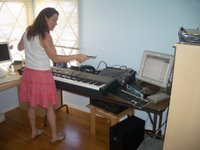 We had more all-rounders this year, so when Jake was editing, I become second unit director and did the interior non-dialog shots, Tim (another engineer) set up the next set and Brian (codec engineer) was script supervisor. We had a great team. In addition to the CineForm guys, we had Jake's brother and sister, Kevin and Kanda (both are far more production- savvy than myself) who provided the lighting setup and sound. For music production and sound design, Renee Coulombe, a professor of music at UCR, set the mood for the entire film, plus acted in the film. Also doing a voice over, Samantha (my wife) wrote the dialog (in 48 hour terms, that means telling the actors their lines; there really is no time for writing things down.)
We had more all-rounders this year, so when Jake was editing, I become second unit director and did the interior non-dialog shots, Tim (another engineer) set up the next set and Brian (codec engineer) was script supervisor. We had a great team. In addition to the CineForm guys, we had Jake's brother and sister, Kevin and Kanda (both are far more production- savvy than myself) who provided the lighting setup and sound. For music production and sound design, Renee Coulombe, a professor of music at UCR, set the mood for the entire film, plus acted in the film. Also doing a voice over, Samantha (my wife) wrote the dialog (in 48 hour terms, that means telling the actors their lines; there really is no time for writing things down.)
On the Sunday we had things mostly under control (normally it is totally out of control.) The one export concern we had was we needed to master a 1920x1080p24 timeline out to 720x480p23.976 as the required deliverable (sadly, no HD projection for the theatre.) We should have shot at 23.976 which is supported by the camera, but due to the lack of setup time, we had shot the first scene exactly at 24 before anyone noticed, so we had to keep the whole production at 24. So early in the day I planned how the export would happen and how much extra time would be needed to master out (and fix the 24 to 23.976 issue.) If we exported from the HD directly to 23.976 DVD or DV (both supported submission formats), several issues would occur. Neither SD exporter used the beautiful 32-bit float that Premiere Pro 2.0 now offers, and the 24 to 23.976 conversion causes frame blending (a nasty ghost in the image.) Instead we exported to 720x480p24 as a CineForm Intermediate AVI; this exporter uses the 32-bit float, so we got the high dynamic range advantages of shooting CineForm RAW, plus it uses a much nicer scaler. Then I did my 24 to 23.976 trick using Virtual Dub (I probably could have used Interpret Footage), instead VirtualDub allows me to change the frame rate using direct stream copy so that there is no time wasted in recompression (i.e. fast.) This resulted in a SD 23.976 CineForm AVI, which was placed into an SD project for encoding M2V (for DVD via Encore.) However, as I had tweaked the video from 24 to 23.976, I need to slow the audio to match; this is done by setting the audio to speed 99.9% (quick and dirty -- works great.) The additional VirtualDub step only added a couple of minutes to our limited post time, and the use of a CineForm SD export improved the quality, so that was worth the time.
Now do you want to see the results?
First let me tell you about the required elements. We drew the genre of Comedy on Friday night, and were required to have these three elements in our movie to be eligible for a prize:
Prop : Beach Towel
Character : Sally or Sam Brown, Event Planner
Line of Dialog : "What would Elvis do?"
So you will see these items pop-up in the movie.
The various on-line HD versions have moved to www.cineform.com/48hour
For those interested in the story, not the image quality, there is a low bit-rate version on YouTube.
I hope you enjoy it.
Thursday, July 20, 2006
Silicon Imaging in 48 hours a Success.
Tuesday, July 18, 2006
Silicon Imaging mini used on 48 Hour Film Project
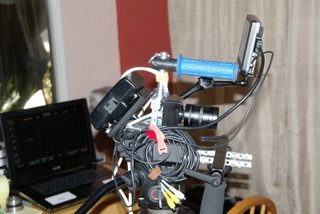 This is a brief announcement for tonight's screening for the 48 Hour Film Project. Every year some of the guys at CineForm put a team into the competition, this year we shot with a prototype Silicon Imaging Mini, capturing to a Sony Viao laptop. The results are stunning.
This is a brief announcement for tonight's screening for the 48 Hour Film Project. Every year some of the guys at CineForm put a team into the competition, this year we shot with a prototype Silicon Imaging Mini, capturing to a Sony Viao laptop. The results are stunning.
We always shoot with the name "Cane Toad Productions", this year we drew comedy and made a film titled "Burnin' Love." Come and see the premiere screening at San Deigo's Landmark La Jolla Village Theater, 8879 Villa La Jolla Drive La Jolla. Here is the Map link. Our film will screen with nine others at 9am tonight. Buy tickets online here as they will likely sell out.
Come and see the premiere screening at San Deigo's Landmark La Jolla Village Theater, 8879 Villa La Jolla Drive La Jolla. Here is the Map link. Our film will screen with nine others at 9am tonight. Buy tickets online here as they will likely sell out.
Subscribe to:
Posts (Atom)